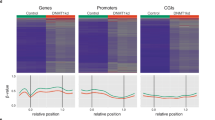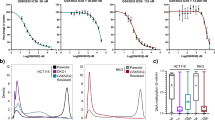Abstract
We report a new mechanism in carcinogenesis involving coordinate long-range epigenetic gene silencing. Epigenetic silencing in cancer has always been envisaged as a local event silencing discrete genes. However, in this study of silencing in colorectal cancer, we found common repression of the entire 4-Mb band of chromosome 2q.14.2, associated with global methylation of histone H3 Lys9. DNA hypermethylation within the repressed genomic neighborhood was localized to three separate enriched CpG island 'suburbs', with the largest hypermethylated suburb spanning 1 Mb. These data change our understanding of epigenetic gene silencing in cancer cells: namely, epigenetic silencing can span large regions of the chromosome, and both DNA-methylated and neighboring unmethylated genes can be coordinately suppressed by global changes in histone modification. We propose that loss of gene expression can occur through long-range epigenetic silencing, with similar implications as loss of heterozygosity in cancer.
This is a preview of subscription content, access via your institution
Access options
Subscribe to this journal
Receive 12 print issues and online access
$209.00 per year
only $17.42 per issue
Buy this article
- Purchase on Springer Link
- Instant access to full article PDF
Prices may be subject to local taxes which are calculated during checkout








Similar content being viewed by others
References
Jones, P.A. & Baylin, S.B. The fundamental role of epigenetic events in cancer. Nat. Rev. Genet. 3, 415–428 (2002).
Laird, P.W. Cancer epigenetics. Hum. Mol. Genet. 14, R65–R76 (2005).
Gardiner-Garden, M. & Frommer, M. CpG islands in vertebrate genomes. J. Mol. Biol. 196, 261–282 (1987).
Lander, E.S. et al. Initial sequencing and analysis of the human genome. Nature 409, 860–921 (2001).
Clark, S.J. & Melki, J. DNA methylation and gene silencing in cancer: which is the guilty party? Oncogene 21, 5380–5387 (2002).
Song, J.Z., Stirzaker, C., Harrison, J., Melki, J.R. & Clark, S.J. Hypermethylation trigger of the glutathione-S-transferase gene (GSTP1) in prostate cancer cells. Oncogene 21, 1048–1061 (2002).
Baylin, S. & Bestor, T.H. Altered methylation patterns in cancer cell genomes: cause or consequence? Cancer Cell 1, 299–305 (2002).
Bachman, K.E. et al. Histone modifications and silencing prior to DNA methylation of a tumor suppressor gene. Cancer Cell 3, 89–95 (2003).
Melki, J.R., Vincent, P.C. & Clark, S.J. Concurrent DNA hypermethylation of multiple genes in acute myeloid leukaemia. Cancer Res. 59, 3730–3740 (1999).
Costello, J.F. et al. Aberrant CpG-island methylation has non-random and tumour-type-specific patterns. Nat. Genet. 24, 132–138 (2000).
Rush, L.J. et al. Epigenetic profiling in chronic lymphocytic leukemia reveals novel methylation targets. Cancer Res. 64, 2424–2433 (2004).
Feltus, F.A., Lee, E.K., Costello, J.F., Plass, C. & Vertino, P.M. Predicting aberrant CpG island methylation. Proc. Natl. Acad. Sci. USA 100, 12253–12258 (2003).
Ushijima, T. Detection and interpretation of altered methylation patterns in cancer cells. Nat. Rev. Cancer 5, 223–231 (2005).
Frigola, J., Ribas, M., Risques, R.A. & Peinado, M.A. Methylome profiling of cancer cells by amplification of inter-methylated sites (AIMS). Nucleic Acids Res. 30, e28 (2002).
Stirzaker, C., Song, J.Z., Davidson, B. & Clark, S.J. Transcriptional gene silencing promotes DNA hypermethylation through a sequential change in chromatin modifications in cancer cells. Cancer Res. 64, 3871–3877 (2004).
Kondo, Y., Shen, L., Yan, P.S., Huang, T.H. & Issa, J.P. Chromatin immunoprecipitation microarrays for identification of genes silenced by histone H3 lysine 9 methylation. Proc. Natl. Acad. Sci. USA 101, 7398–7403 (2004).
Frigola, J. et al. Differential DNA hypermethylation and hypomethylation signatures in colorectal cancer. Hum. Mol. Genet. 14, 319–326 (2005).
Kangas, M. et al. Structure and chromosomal localization of the human and murine genes for the macrophage MARCO receptor. Genomics 58, 82–89 (1999).
Gui, C.Y., Ngo, L., Xu, W.S., Richon, V.M. & Marks, P.A. Histone deacetylase (HDAC) inhibitor activation of p21WAF1 involves changes in promoter-associated proteins, including HDAC1. Proc. Natl. Acad. Sci. USA 101, 1241–1246 (2004).
Archer, S.Y., Meng, S., Shei, A. & Hodin, R.A. p21(WAF1) is required for butyrate-mediated growth inhibition of human colon cancer cells. Proc. Natl. Acad. Sci. USA 95, 6791–6796 (1998).
Zhu, W.G. et al. 5-aza-2′-deoxycytidine activates the p53/p21Waf1/Cip1 pathway to inhibit cell proliferation. J. Biol. Chem. 279, 15161–15166 (2004).
Huschtscha, L.I. et al. Loss of p16INK4 expression by methylation is associated with lifespan extension of human mammary epithelial cells. Cancer Res. 58, 3508–3512 (1998).
Weber, M. et al. Chromosome-wide and promoter-specific analyses identify sites of differential DNA methylation in normal and transformed human cells. Nat. Genet. 37, 853–862 (2005).
Nie, Y. et al. DNA hypermethylation is a mechanism for loss of expression of the HLA class I genes in human esophageal squamous cell carcinomas. Carcinogenesis 22, 1615–1623 (2001).
van Noesel, M.M. et al. Clustering of hypermethylated genes in neuroblastoma. Genes Chromosom. Cancer 38, 226–233 (2003).
Palmisano, W.A. et al. Aberrant promoter methylation of the transcription factor genes PAX5 alpha and beta in human cancers. Cancer Res. 63, 4620–4625 (2003).
Brockdorff, N. X-chromosome inactivation: closing in on proteins that bind Xist RNA. Trends Genet. 18, 352–358 (2002).
Latham, K.E. X chromosome imprinting and inactivation in preimplantation mammalian embryos. Trends Genet. 21, 120–127 (2005).
Plath, K., Mlynarczyk-Evans, S., Nusinow, D.A. & Panning, B. Xist RNA and the mechanism of X chromosome inactivation. Annu. Rev. Genet. 36, 233–278 (2002).
Lippman, Z. & Martienssen, R. The role of RNA interference in heterochromatic silencing. Nature 431, 364–370 (2004).
O'Neill, M.J. The influence of non-coding RNAs on allele-specific gene expression in mammals. Hum. Mol. Genet. 14, R113–R120 (2005).
Jaffrey, R.G. et al. Genomic instability at the BUB1 locus in colorectal cancer, but not in non-small cell lung cancer. Cancer Res. 60, 4349–4352 (2000).
Moon, R.T., Kohn, A.D., De Ferrari, G.V. & Kaykas, A. WNT and beta-catenin signalling: diseases and therapies. Nat. Rev. Genet. 5, 691–701 (2004).
Adamska, M., MacDonald, B.T., Sarmast, Z.H., Oliver, E.R. & Meisler, M.H. En1 and Wnt7a interact with Dkk1 during limb development in the mouse. Dev. Biol. 272, 134–144 (2004).
Pang, R.T., Lee, L.T., Ng, S.S., Yung, W.H. & Chow, B.K. CpG methylation and transcription factors Sp1 and Sp3 regulate the expression of the human secretin receptor gene. Mol. Endocrinol. 18, 471–483 (2004).
Tang, C. et al. Expression of receptors for gut peptides in pancreata of BOP-treated and control hamsters. Carcinogenesis 17, 2171–2175 (1996).
Tang, C., Biemond, I. & Lamers, C.B. Expression of peptide receptors in human endocrine tumours of the pancreas. Gut 40, 267–271 (1997).
Reis, F.M. et al. Activin, inhibin and the human breast. Mol. Cell. Endocrinol. 225, 77–82 (2004).
Mylonas, I. et al. Inhibin/activin subunits (inhibin-alpha, -betaA and -betaB) are differentially expressed in human breast cancer and their metastasis. Oncol. Rep. 13, 81–88 (2005).
Sims, R.J., III, Nishioka, K. & Reinberg, D. Histone lysine methylation: a signature for chromatin function. Trends Genet. 19, 629–639 (2003).
Mutskov, V. & Felsenfeld, G. Silencing of transgene transcription precedes methylation of promoter DNA and histone H3 lysine 9. EMBO J. 23, 138–149 (2004).
Gius, D. et al. Distinct effects on gene expression of chemical and genetic manipulation of the cancer epigenome revealed by a multimodality approach. Cancer Cell 6, 361–371 (2004).
Bird, A. DNA methylation patterns and epigenetic memory. Genes Dev. 16, 6–21 (2002).
Lorincz, M.C., Schubeler, D., Hutchinson, S.R., Dickerson, D.R. & Groudine, M. DNA methylation density influences the stability of an epigenetic imprint and Dnmt3a/b-independent de novo methylation. Mol. Cell. Biol. 22, 7572–7580 (2002).
Nguyen, C. et al. Susceptibility of nonpromoter CpG islands to de novo methylation in normal and neoplastic cells. J. Natl. Cancer Inst. 93, 1465–1472 (2001).
Lorincz, M.C., Dickerson, D.R., Schmitt, M. & Groudine, M. Intragenic DNA methylation alters chromatin structure and elongation efficiency in mammalian cells. Nat. Struct. Mol. Biol. 11, 1068–1075 (2004).
Clark, S.J., Harrison, J., Paul, C.L. & Frommer, M. High sensitivity mapping of methylated cytosines. Nucleic Acids Res. 22, 2990–2997 (1994).
Acknowledgements
We thank J. Rodriguez for LOH analysis, G. Aiza and M. Muñoz for technical help, P. Molloy for reading the manuscript and A. Statham for help with figures. This work was supported in part by a grant from the Australian National Health and Medical Research Council (NH&MRC; grants 293810 and 325622) and a grant from the Spanish Ministry of Education and Science (SAF2003/5821). J.F. is a fellow of the Spanish Ministry of Education and Science (FPU program) at the Universitat Autonoma de Barcelona and S.J.C. is a principal research fellow of NH&MRC (293811).
Author information
Authors and Affiliations
Corresponding author
Ethics declarations
Competing interests
The authors declare no competing financial interests.
Supplementary information
Supplementary Fig. 1
Identification of a differentially methylated region in colorectal cancer using AIMS. (PDF 353 kb)
Supplementary Fig. 2
Ten defined genes are located in 2q14.2. (PDF 285 kb)
Supplementary Fig. 3
Direct genomic bisulfite sequencing across chromosome 2q14.2 (PDF 1176 kb)
Supplementary Fig. 4
Genomic bisulfite sequencing of individual clones of the CpG islands across 2q14.2. (PDF 1154 kb)
Supplementary Fig. 5
Real-time RT-PCR and temperature dissociation profiles. (PDF 1176 kb)
Supplementary Fig. 6
Chromatin immunoprecipitation real-time PCR and temperature dissociation profiles. (PDF 1068 kb)
Supplementary Table 1
Primers used for bisulfite sequencing, RT-PCR and ChIP analysis. (PDF 67 kb)
Rights and permissions
About this article
Cite this article
Frigola, J., Song, J., Stirzaker, C. et al. Epigenetic remodeling in colorectal cancer results in coordinate gene suppression across an entire chromosome band. Nat Genet 38, 540–549 (2006). https://doi.org/10.1038/ng1781
Received:
Accepted:
Published:
Issue Date:
DOI: https://doi.org/10.1038/ng1781
This article is cited by
-
Dual-modality loop-mediated isothermal amplification for pretreatment-free detection of Septin9 methylated DNA in colorectal cancer
Microchimica Acta (2021)
-
Dynamics of genome architecture and chromatin function during human B cell differentiation and neoplastic transformation
Nature Communications (2021)
-
Amplified electrochemical immunoassay for 5-methylcytosine using a nanocomposite prepared from graphene oxide, magnetite nanoparticles and β-cyclodextrin
Microchimica Acta (2019)
-
Double signal enhancement strategy based on rolling circle amplification and photoinduced electron transfer for ultrasensitive fluorometric detection of methylated DNA
Microchimica Acta (2018)
-
SegCorr a statistical procedure for the detection of genomic regions of correlated expression
BMC Bioinformatics (2017)



